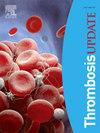Clinical outcomes of direct oral anticoagulant off-label dosing in nonvalvular atrial fibrillation
Q4 Medicine
引用次数: 0
Abstract
Introduction
Direct oral anticoagulants (DOACs) used in nonvalvular atrial fibrillation (NVAF) are superior or non-inferior to warfarin in reducing the risk of stroke while at the same time having a similar or lower risk of bleeding. However, reduced doses are prescribed more often than expected from clinical practice and off-label underdosing is a frequent issue. The objective of this study was to compare effectiveness and safety between guideline and off-label dosing of DOACs.
Materials and methods
Auricula, a Swedish anticoagulation registry was used in identifying eligible patients from July 2011 to December 2017. The study cohort consisted of 47,355 patients with newly initiated DOAC (apixaban, dabigatran, or rivaroxaban) after exclusion of 92,316 patients due to concomitant venous thromboembolism, previous mechanical heart valve (MHV) or previous data entry in Auricula. The median durations of follow up were 403, 419, 373 and 209 days in the on-label standard dose cohort, off-label reduced dose cohort, on-label reduced dose cohort and the off-label standard dose cohort respectively. Endpoints (stroke and major bleeding) and baseline characteristics were collected from hospital administrative registers using ICD-10 codes or the Swedish Stroke register. Cohorts were compared using weighted adjusted Cox regression after full optimal matching based on propensity scores.
Results
Off-label underdosing of DOACs (n = 6,187, 9.7 %) was associated with higher risk of major bleeding HR 1.16 (95 % CI 1.05–1.27), other bleeding HR 1.16 (1.04–1.30), myocardial infarction HR 1.47 (1.20–1.80), ischemic stroke HR 1.25 (1.04–1.50) and all-cause mortality HR 1.52 (1.37–1.69) compared to on-label standard dosing (n = 35,065, 55.2 %). Among off-label underdosed DOACs, dabigatran was associated with higher risk of all-cause stroke 1.86 (1.07–3.23), ischemic stroke HR 1.97 (1.10–3.52) and all-cause stroke and systemic embolism HR 1.92 (1.11–3.32) compared to apixaban. Rivaroxaban was associated with major bleeding HR 1.70 (1.41–2.03), gastrointestinal bleeding HR 1.92 (1.33–2.77), and other bleeding HR 1.97 (1.57–2.47) compared to apixaban. The study could not show any differences comparing off-label overdosing of DOACs and on-label reduced dosing, besides lower risk of all-cause mortality HR 0.69 (0.52–0.93) in the overdosed patients.
Conclusions
In this large observational registry-based NVAF cohort, underdosing of DOACs is associated with higher risk of ischemic and all-cause stroke but also major bleeding when compared to on-label dosing. Underlying DOAC therapy may need to be tailored to the specific patient when choosing off-label reduced dosing since underdosed rivaroxaban is associated with higher risk of bleeding complications, and underdosed dabigatran is associated with higher risk of stroke complications, when comparing both with apixaban.

非瓣膜性房颤直接口服超说明书剂量抗凝药物的临床疗效
直接口服抗凝剂(DOACs)用于非瓣膜性房颤(NVAF)在降低卒中风险方面优于或不低于华法林,同时出血风险相似或更低。然而,减少剂量的处方比临床实践中预期的要多,并且标签外剂量不足是一个常见的问题。本研究的目的是比较指南和说明书外剂量的doac的有效性和安全性。材料和方法:2011年7月至2017年12月,使用瑞典抗凝登记系统sauricula确定符合条件的患者。该研究队列包括47,355例新开始DOAC(阿哌沙班、达比加群或利伐沙班)的患者,排除了92,316例因合并静脉血栓栓塞、既往机械心脏瓣膜(MHV)或既往在Auricula中输入数据的患者。标签上标准剂量组、标签外减少剂量组、标签上减少剂量组和标签外标准剂量组的中位随访时间分别为403、419、373和209天。终点(中风和大出血)和基线特征收集自使用ICD-10代码或瑞典中风登记的医院行政登记册。在基于倾向得分的完全最优匹配后,使用加权调整Cox回归对队列进行比较。结果与标签上的标准剂量(n = 35,065, 55.2%)相比,标签上的DOACs剂量不足(n = 6,187, 9.7%)与主要出血(HR 1.16, 95% CI 1.05-1.27)、其他出血(HR 1.16, 1.04-1.30)、心肌梗死(HR 1.47, 1.20-1.80)、缺血性卒中(HR 1.25, 1.04-1.50)和全因死亡率(HR 1.52, 1.37-1.69)相关。在标签外用药不足的doac中,与阿哌沙班相比,达比加群的全因卒中风险为1.86(1.07-3.23),缺血性卒中风险为1.97(1.10-3.52),全因卒中和全身栓塞风险为1.92(1.11-3.32)。与阿哌沙班相比,利伐沙班与大出血相关的HR为1.70(1.41-2.03),胃肠道出血相关HR为1.92(1.33-2.77),其他出血相关HR为1.97(1.57-2.47)。该研究并没有显示DOACs的标签外过量和标签内减少剂量的差异,除了过量患者的全因死亡风险较低HR 0.69(0.52-0.93)。结论:在这个基于登记的大型非瓣膜性房颤观察队列中,与标签上的剂量相比,DOACs的剂量不足与缺血性和全因卒中的风险增加有关,但也与大出血有关。当选择标签外减少剂量时,潜在的DOAC治疗可能需要针对特定患者进行定制,因为与阿哌沙班相比,利伐沙班剂量不足与出血并发症的高风险相关,达比加群剂量不足与卒中并发症的高风险相关。
本文章由计算机程序翻译,如有差异,请以英文原文为准。
求助全文
约1分钟内获得全文
求助全文

 求助内容:
求助内容: 应助结果提醒方式:
应助结果提醒方式:


